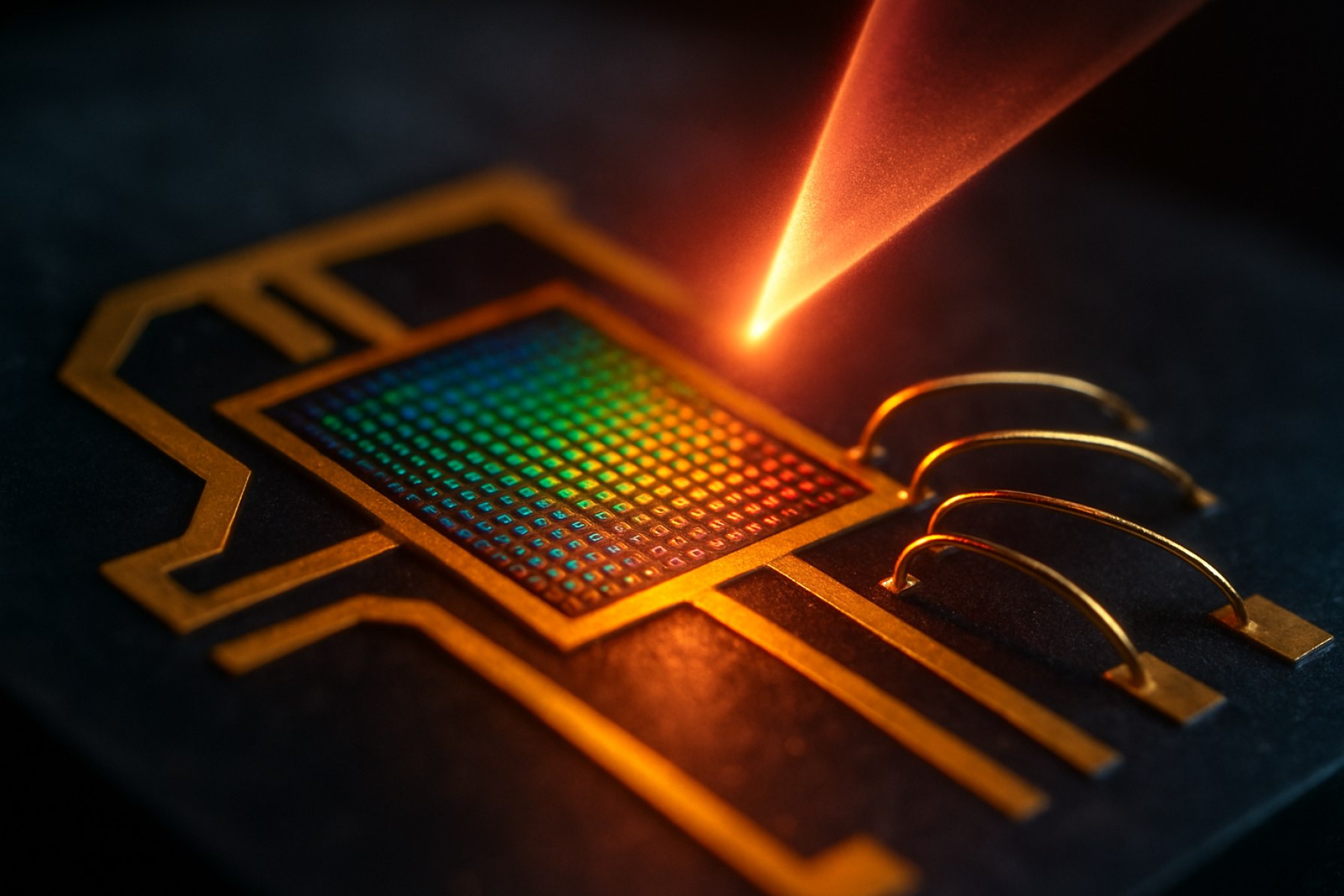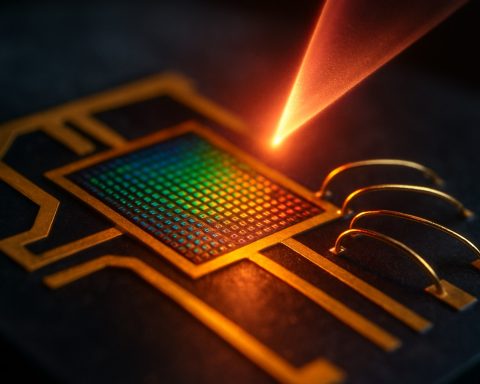Unlocking the Power of Quantum-Dot Mid-Infrared Photodetectors: How Nanoscale Engineering Is Revolutionizing Sensing, Imaging, and Security Applications
- Introduction to Quantum-Dot Mid-Infrared Photodetectors
- How Quantum Dots Enhance Mid-Infrared Detection
- Key Materials and Fabrication Techniques
- Performance Metrics: Sensitivity, Speed, and Noise
- Breakthrough Applications: From Medical Diagnostics to Environmental Monitoring
- Comparative Advantages Over Traditional Photodetectors
- Current Challenges and Limitations
- Recent Research Highlights and Industry Developments
- Future Prospects and Emerging Trends
- Conclusion: The Road Ahead for Quantum-Dot Mid-Infrared Photodetectors
- Sources & References
Introduction to Quantum-Dot Mid-Infrared Photodetectors
Quantum-dot mid-infrared photodetectors (QD-MIRPDs) represent a rapidly advancing class of optoelectronic devices that leverage the unique properties of quantum dots (QDs) to detect mid-infrared (MIR) radiation, typically in the wavelength range of 3–30 μm. Unlike traditional bulk or quantum well photodetectors, QD-MIRPDs utilize zero-dimensional semiconductor nanostructures, which offer discrete energy levels and strong quantum confinement effects. These features enable enhanced tunability of the absorption spectrum, reduced dark current, and improved operating temperatures, making QD-MIRPDs highly attractive for applications in environmental monitoring, medical diagnostics, chemical sensing, and military surveillance.
The integration of quantum dots into photodetector architectures allows for the engineering of device characteristics by controlling QD size, composition, and spatial arrangement. This flexibility facilitates the design of detectors with tailored spectral responses and improved signal-to-noise ratios. Furthermore, QD-MIRPDs can be fabricated using various material systems, such as InAs/GaAs or PbSe/CdSe, each offering distinct advantages in terms of sensitivity and operational wavelength range.
Recent research has demonstrated significant progress in the performance of QD-MIRPDs, including higher detectivity and lower noise compared to conventional technologies. These advancements are supported by ongoing developments in nanofabrication and material synthesis techniques, as highlighted by organizations such as the National Institute of Standards and Technology and the Nature Publishing Group. As the field continues to evolve, QD-MIRPDs are poised to play a pivotal role in next-generation infrared sensing technologies.
How Quantum Dots Enhance Mid-Infrared Detection
Quantum dots (QDs) significantly enhance the performance of mid-infrared (mid-IR) photodetectors by leveraging their unique quantum confinement effects. Unlike bulk or quantum well structures, QDs possess discrete energy levels due to their nanoscale dimensions, which can be precisely engineered to tailor the absorption spectrum for specific mid-IR wavelengths. This tunability allows for the design of photodetectors that are highly sensitive to targeted spectral regions, improving selectivity and efficiency in applications such as environmental monitoring, medical diagnostics, and free-space optical communications.
One of the primary advantages of QD-based mid-IR photodetectors is their ability to suppress dark current, a major source of noise in conventional photodetectors. The three-dimensional carrier confinement in QDs reduces the probability of thermally generated carriers contributing to the dark current, thereby enhancing the signal-to-noise ratio and enabling operation at higher temperatures without significant performance degradation. This characteristic is particularly valuable for developing compact, low-power, and uncooled mid-IR detection systems Nature Reviews Materials.
Furthermore, QDs can be integrated into various device architectures, such as quantum-dot infrared photodetectors (QDIPs) and quantum-dot photoconductors, to exploit phenomena like intraband and intersubband transitions. These mechanisms enable efficient photon absorption and carrier extraction in the mid-IR range, often surpassing the performance of traditional quantum well infrared photodetectors (QWIPs) in terms of responsivity and detectivity IEEE Xplore. As a result, quantum dots are at the forefront of advancing mid-IR photodetector technology, offering new opportunities for high-performance, application-specific sensors.
Key Materials and Fabrication Techniques
Quantum-dot mid-infrared photodetectors (QD-MIRPDs) leverage the unique quantum confinement effects of semiconductor nanocrystals to achieve tunable and sensitive detection in the mid-infrared (MIR) spectral range. The performance and scalability of these devices are critically dependent on the choice of materials and the employed fabrication techniques.
The most widely used quantum dot materials for MIR photodetectors are narrow-bandgap semiconductors such as lead chalcogenides (PbS, PbSe), mercury chalcogenides (HgTe), and III-V compounds like InAs and InSb. These materials offer strong absorption in the MIR due to their size-tunable bandgaps and high carrier mobilities. Colloidal synthesis methods allow for precise control over quantum dot size and composition, enabling spectral tuning across the 2–12 μm range. Surface passivation and ligand exchange processes are essential to enhance carrier transport and reduce trap states, which are critical for device efficiency and noise reduction Nature Reviews Materials.
Fabrication techniques for QD-MIRPDs typically involve solution-based deposition methods such as spin-coating, dip-coating, or inkjet printing, which are compatible with large-area and flexible substrates. These methods facilitate low-cost, scalable production compared to traditional epitaxial growth. Integration with microfabricated electrodes and dielectric layers is achieved through standard photolithography and lift-off processes. Recent advances include the use of hybrid structures, combining quantum dots with two-dimensional materials (e.g., graphene) to enhance charge extraction and responsivity Materials Today.
Overall, the interplay between material selection, surface chemistry, and fabrication methodology is pivotal in optimizing the performance and manufacturability of quantum-dot mid-infrared photodetectors.
Performance Metrics: Sensitivity, Speed, and Noise
The performance of quantum-dot mid-infrared photodetectors (QD-MIRPDs) is primarily evaluated through three critical metrics: sensitivity, speed, and noise. Sensitivity, often quantified by the specific detectivity (D*), reflects the device’s ability to discern weak infrared signals from the background. Quantum dots (QDs) offer discrete energy levels and strong quantum confinement, which can enhance absorption cross-sections and enable high responsivity, even at reduced device thicknesses. This property is particularly advantageous for mid-infrared detection, where photon energies are lower and efficient absorption is challenging Nature Photonics.
Speed, or temporal response, is another vital parameter, especially for applications in real-time imaging and high-speed communications. The carrier dynamics in QD-MIRPDs are influenced by the quantum dot size, composition, and the surrounding matrix. Fast carrier extraction and short transit times are achievable due to the reduced dimensionality and engineered band structures, allowing for sub-nanosecond response times in optimized devices Materials Today.
Noise, particularly dark current and noise equivalent power (NEP), limits the minimum detectable signal. QDs can suppress dark current through spatial and energy filtering, as their discrete states reduce thermally activated carrier generation. However, surface states and interface traps can introduce additional noise sources, necessitating careful material and interface engineering Optics Express. Overall, the interplay between these metrics determines the suitability of QD-MIRPDs for demanding mid-infrared sensing applications.
Breakthrough Applications: From Medical Diagnostics to Environmental Monitoring
Quantum-dot mid-infrared photodetectors (QD-MIRPDs) are rapidly transforming a range of fields through their unique combination of high sensitivity, spectral tunability, and potential for integration into compact, low-power devices. In medical diagnostics, QD-MIRPDs enable non-invasive detection of biomarkers in breath, blood, or tissue by targeting specific mid-infrared absorption features of molecules such as glucose, urea, or volatile organic compounds. This capability paves the way for real-time, point-of-care diagnostic tools that can detect diseases at early stages, improving patient outcomes and reducing healthcare costs. For example, QD-MIRPDs have been explored for breath analysis to identify early signs of lung cancer and metabolic disorders, leveraging their ability to discriminate between subtle molecular signatures in complex biological samples (Nature Nanotechnology).
In environmental monitoring, QD-MIRPDs offer significant advantages for detecting trace gases and pollutants, such as methane, carbon dioxide, and nitrogen oxides, which have strong absorption lines in the mid-infrared region. Their high sensitivity and selectivity enable real-time, on-site monitoring of air and water quality, supporting regulatory compliance and early warning systems for hazardous leaks or contamination events. The integration of QD-MIRPDs into portable sensor platforms and unmanned aerial vehicles further extends their reach, allowing for rapid, large-area environmental assessments (Materials Today).
These breakthrough applications underscore the transformative potential of QD-MIRPDs, as ongoing advances in quantum-dot synthesis, device engineering, and system integration continue to expand their impact across healthcare, environmental science, and beyond.
Comparative Advantages Over Traditional Photodetectors
Quantum-dot mid-infrared photodetectors (QD-MIRPDs) offer several comparative advantages over traditional photodetector technologies such as mercury cadmium telluride (MCT) and quantum well infrared photodetectors (QWIPs). One of the most significant benefits is their ability to operate efficiently at higher temperatures, often above 200 K, which reduces or eliminates the need for expensive cryogenic cooling systems required by MCT devices. This is primarily due to the three-dimensional carrier confinement in quantum dots, which suppresses dark current and enhances signal-to-noise ratios Nature Reviews Materials.
QD-MIRPDs also exhibit enhanced wavelength tunability. By engineering the size, shape, and composition of quantum dots, the absorption spectrum can be precisely tailored to target specific mid-infrared wavelengths, a flexibility not easily achievable with bulk or quantum well materials Materials Today. This tunability is particularly advantageous for applications in multispectral imaging and chemical sensing, where detection of distinct spectral features is crucial.
Furthermore, quantum-dot photodetectors can be fabricated using less toxic and more abundant materials compared to MCT, addressing environmental and supply chain concerns. Their compatibility with silicon-based processing also enables the integration of QD-MIRPDs with standard CMOS electronics, paving the way for compact, low-cost, and scalable infrared imaging systems Optics Express. Collectively, these advantages position QD-MIRPDs as promising candidates for next-generation mid-infrared detection technologies.
Current Challenges and Limitations
Quantum-dot mid-infrared photodetectors (QD-MIRPDs) have garnered significant attention due to their potential for high sensitivity, tunable spectral response, and compatibility with silicon-based technologies. However, several challenges and limitations currently hinder their widespread adoption and commercial viability. One of the primary issues is the relatively low quantum efficiency compared to traditional photodetector technologies, such as mercury cadmium telluride (MCT) and quantum well infrared photodetectors (QWIPs). This limitation is often attributed to non-radiative recombination processes and incomplete carrier extraction within the quantum-dot layers, which reduce the overall photocurrent generation Nature Reviews Materials.
Another significant challenge is the presence of high dark current, which arises from thermally generated carriers and defect states within the quantum-dot material and at interfaces. High dark current degrades the signal-to-noise ratio, limiting the detector’s sensitivity, especially at elevated operating temperatures. Efforts to suppress dark current, such as advanced passivation techniques and optimized device architectures, are ongoing but have yet to fully resolve the issue Materials Today.
Uniformity and reproducibility of quantum-dot synthesis and device fabrication also remain problematic. Variations in quantum-dot size, composition, and distribution can lead to inhomogeneous spectral response and inconsistent device performance. Furthermore, the long-term stability and reliability of QD-MIRPDs under operational conditions are not yet fully established, posing additional barriers to commercialization Optics Express.
Recent Research Highlights and Industry Developments
Recent years have witnessed significant advancements in the field of quantum-dot mid-infrared photodetectors (QD-MIRPDs), driven by both academic research and industry initiatives. Notably, research groups have achieved substantial improvements in device responsivity, detectivity, and operational stability by engineering quantum dot (QD) materials and device architectures. For instance, the integration of colloidal QDs with advanced heterostructures has enabled room-temperature detection capabilities, a critical milestone for practical applications in imaging, environmental monitoring, and free-space optical communications. Researchers at institutions such as the National Institute of Standards and Technology and Nature Nanotechnology have reported QD-MIRPDs with detectivities exceeding 1010 Jones, rivaling traditional mercury cadmium telluride (MCT) detectors but with the added benefits of solution processability and tunable spectral response.
On the industry front, companies like Quantum Solutions and Sensera are actively developing QD-based photodetector platforms targeting commercial and defense markets. These efforts focus on scalable fabrication methods, such as inkjet printing and roll-to-roll processing, to reduce production costs and enable integration with silicon-based electronics. Furthermore, collaborations between industry and academia are accelerating the translation of laboratory breakthroughs into deployable sensor systems, as evidenced by joint projects funded by agencies like the Defense Advanced Research Projects Agency (DARPA).
Overall, the synergy between fundamental research and industrial innovation is rapidly advancing the performance and manufacturability of QD-MIRPDs, positioning them as promising candidates for next-generation infrared sensing technologies.
Future Prospects and Emerging Trends
The future of quantum-dot mid-infrared photodetectors (QD-MIRPDs) is marked by rapid advancements in material engineering, device architecture, and integration strategies. One emerging trend is the development of colloidal quantum dots with tailored bandgaps, enabling detection across a broader mid-infrared spectrum and enhancing device sensitivity and selectivity. Researchers are increasingly focusing on lead chalcogenide and mercury telluride quantum dots, which offer tunable absorption properties and compatibility with low-cost, solution-based fabrication methods. This could significantly reduce manufacturing costs and facilitate large-area detector arrays for applications in environmental monitoring, medical diagnostics, and security imaging.
Another promising direction is the integration of QD-MIRPDs with silicon photonics platforms, paving the way for compact, on-chip spectroscopic systems. Such integration leverages the scalability of silicon technology while harnessing the unique optoelectronic properties of quantum dots. Additionally, advances in surface passivation and ligand engineering are addressing long-standing challenges related to carrier recombination and device stability, thereby improving operational lifetimes and performance at room temperature.
Looking ahead, the convergence of QD-MIRPDs with artificial intelligence and machine learning is anticipated to enable smart sensing systems capable of real-time data analysis and adaptive response. The ongoing research and collaborative efforts, as highlighted by organizations such as the Nature Reviews Materials and the National Institute of Standards and Technology, underscore the transformative potential of QD-MIRPDs in next-generation photonic and optoelectronic technologies.
Conclusion: The Road Ahead for Quantum-Dot Mid-Infrared Photodetectors
Quantum-dot mid-infrared photodetectors (QD-MIRPDs) have demonstrated significant potential for revolutionizing infrared sensing technologies, offering advantages such as tunable spectral response, high sensitivity, and compatibility with silicon-based integration. Despite these advances, several challenges remain before QD-MIRPDs can achieve widespread commercial adoption. Key issues include optimizing quantum dot synthesis for uniformity and stability, improving device architectures to minimize dark current and noise, and scaling up fabrication processes for large-area, cost-effective production. Addressing these challenges will require interdisciplinary collaboration across materials science, device engineering, and system integration.
Looking forward, the integration of QD-MIRPDs with complementary metal-oxide-semiconductor (CMOS) technology is a promising direction, enabling compact, low-power, and high-performance infrared imaging systems. Additionally, advances in colloidal quantum dot chemistry and surface passivation are expected to further enhance device performance and operational stability. The development of multi-spectral and broadband detectors, leveraging the tunability of quantum dots, could open new applications in environmental monitoring, medical diagnostics, and security imaging. Continued support from research initiatives and industry partnerships, such as those led by Defense Advanced Research Projects Agency (DARPA) and National Science Foundation (NSF), will be crucial in driving innovation and overcoming current limitations.
In summary, while QD-MIRPDs are still maturing, their unique properties position them at the forefront of next-generation infrared photodetection. With sustained research and development, these devices are poised to play a transformative role in a wide range of scientific and technological domains.
Sources & References
- National Institute of Standards and Technology
- Nature Publishing Group
- Quantum Solutions
- Sensera
- Defense Advanced Research Projects Agency
- National Science Foundation (NSF)
https://youtube.com/watch?v=QEQYJHK4oOA










